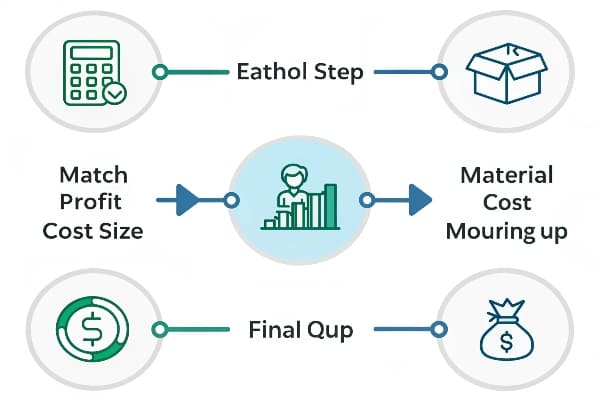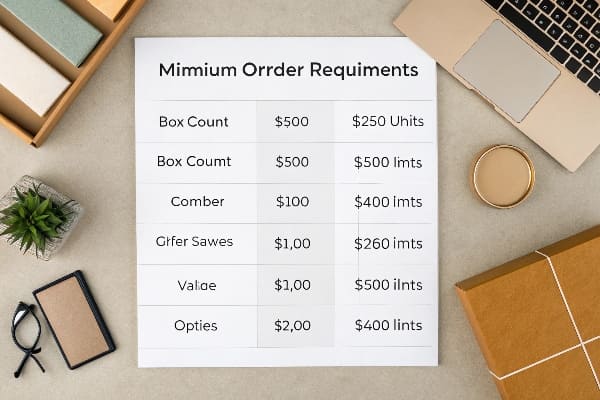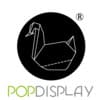I know MOQ feels like a wall. You have a launch date. You need numbers that make sense. You need them fast.
My standard MOQ is 300–500 units for mailer or corrugated gift boxes, 500–1,000 units for rigid set-up boxes, and 100–300 units for short-run digital jobs. One size and one design per MOQ.

If you only want a few dozen boxes, I still help with samples and design. I do this because repeat orders drive profit for both of us. Start small with a pilot, then scale once the display and packaging convert on shelf.
What is the minimum order quantity requirement?
Many buyers ask for 50 or 100 boxes. I get it. Budgets are tight. But production has a base cost. Machines, make-ready, and raw paper rolls do not shrink below a floor. MOQ protects unit cost and color stability.
My MOQ depends on structure, print method, and board. Digital jobs allow 100–300 units. Flexo or offset with custom dies works best from 500 units. Rigid boxes need 500–1,000 units. Inserts or special finishes may push the MOQ higher.

Why a floor exists
I speak as a factory owner in Shenzhen with three lines. We change dies, plates, inks, and glues many times a day. Each change takes set-up sheets, time, and people. Paper and corrugated come in parent sheets or rolls with supplier MOQs1. If I run too few pieces, waste rises and color shifts. Your cost per unit2 jumps.
What affects the MOQ
| Factor | Typical Impact | Notes |
|---|---|---|
| Box type | Rigid > Corrugated > Paperboard | Rigid needs more hand work and lining paper |
| Print method | Offset/Flexo ≥500; Digital ≥100 | Offset gives best color for large areas |
| Size | Larger box, higher waste | Fewer ups per sheet |
| Finish | Foil, Spot UV, Emboss | Often adds 200–500 units to be economical |
| Insert | Foam, pulp, paper | Extra die-cut or mold MOQ applies |
| Multi-SKU | Per-design MOQ | Combine runs only if same die and colors |
A quick story
I once tried a 150-unit rigid run for a holiday VIP kit. The sheets looked fine at make-ready. After lamination, two panels showed scuff. We reprinted. Cost doubled. We learned to hold the 500-unit floor for rigid.
How to calculate the minimum order quantity?
You can guess a number, or you can do a simple calculation. I prefer a clear method. It sets the right expectation before we quote.
I calculate MOQ from sheet yield, press set-up time, supplier material MOQs, and waste. If the math says 420 units, I round to the next carton or pallet tier, usually 500.

The simple framework
1. Define the box size, structure, and insert.
2. Select the print method: digital, flexo, or offset.
3. Lay out how many boxes fit on one parent sheet (the “ups”).
4. Add make-ready sheets and expected waste.
5. Check supplier MOQs for board, liner, foil, and foam.
6. Choose the smallest quantity that keeps unit cost stable.
*7. Round to full master cartons or a pallet layer.
A plain-English formula
MOQ = max(Press_Min_Run, Material_MOQ / Yield) × Waste_Factor, then round to shipping tiers.
- Press_Min_Run: the fewest sheets that justify make-ready (e.g., 250–400 sheets for offset).
- Material_MOQ: minimum from paper, foil, or foam suppliers.
- Yield: number of boxes per sheet after die-cut.
- Waste_Factor: 1.05–1.15 for set-up, color tuning, and QC.
Example table
| Input | Value | Meaning |
|---|---|---|
| Parent sheet | 28"×40" | Common offset size |
| Box blank | 9"×11" | Fits 6-up per sheet |
| Press_Min_Run | 300 sheets | At least 300 sheets to stabilize color |
| Material_MOQ | 2,000 blanks | Supplier minimum after lamination |
| Yield | 6 | 6 blanks per sheet |
| Waste_Factor | 1.10 | 10% for tuning and QC |
| Calculated MOQ | max(300×6, 2,000)×1.10 = 2,200 | Round to 2,250 or 2,500 for cartons |
Why I sometimes suggest digital
If you are testing a new SKU, digital avoids plates and dies. You pay more per unit but less upfront. You can order 150–300 units, learn, then switch to offset at 500–1,000+ units when demand is clear.
What is a good size for a gift box?
A “good” size is one that fits the product, ships well, and looks right on shelf. I start from the product and inserts, then I map to sheet and carton sizes.
Pick internal size based on product plus inserts, then check shipping carton and pallet fit. Avoid air space. Use common sheet breaks to control waste and cost.

Common starting points
For beauty sets and small electronics, these ranges work well. I adjust wall thickness and inserts by weight.
| Use Case | Inside Size (L×W×H) | Notes |
|---|---|---|
| Jewelry/Accessory | 4"×4"×2" | Paperboard or small rigid |
| Candle 8–12 oz | 4.25"×4.25"×4.75" | Add pulp or foam collar |
| Skincare set | 9"×7"×3" | Rigid base-lid with tray |
| Electronics accessory | 8"×5"×3" | Corrugated mailer with insert |
| Apparel light | 12"×9"×2" | Fold-over mailer, E-flute |
| Premium gift | 12"×10"×5" | Rigid with ribbon and magnet |
How I choose the final size
I measure the product and any retail display needs. I plan foam, pulp, or paper inserts for drop protection3. I then check standard carton footprints to hit a clean pallet. For North America, I like 40"×48" pallets. I stack cartons in even layers to reduce freight. I also match sizes to parent sheets. A 9"×11" blank plays nicely on a 28"×40" sheet. This keeps yield high and ink coverage even.
A note on look and sustainability
Clean lines and bold type help the brand. Recyclable boards and water-based inks pass audits and please buyers. This aligns with what I see in the display market. Brands ask for sustainable choices4 first. Asia-Pacific has strong board supply. Europe pushes eco standards. I follow both trends when I design boxes for US and Canada clients.
What is the minimum order requirement?
MOQ is one rule. Many buyers also ask about the minimum order requirement (MOR) or minimum order value (MOV). This is not the same. It ties to dollars, not pieces.
My minimum order requirement focuses on one production run per size and design, usually with a target order value to cover set-up. I combine SKUs only when they share dies and colors.

What I include in the requirement
-. Pieces per design: the MOQ numbers above.
-. Order value floor: a small floor to cover make-ready and QC.
-. Shared components: I merge SKUs that use the same die and inks.
-. Lead time5: samples 5–7 days; mass 10–20 days after approval.
-. Quality gates: strength test, transit test, color delta checks.
Clear comparison
| Term | What it means | Typical Range | How to lower it |
|---|---|---|---|
| MOQ (pieces)6 | Units per design | 300–1,000 | Use digital or share dies |
| MOV (value) | Dollar floor per PO | Factory-specific | Combine SKUs into one run |
| Lead time | Days to ship | 10–20 days | Approve samples fast |
| Sample policy | One pre-production set | Free modifications | Lock art and dieline early |
Why this helps you launch on time
I work with brands that run tight windows. Outdoor gear, beauty, toys. I set the rules above to keep cost and risk low. If you bring final art and a locked dieline, I print fast. If you need a test, I run digital first. Once sales data comes in, I move to offset and lower unit cost. This is how I support repeat orders, which is where we both win.
Conclusion
Choose the right MOQ by structure, print, and size. Start small with digital if you test. Lock dieline early. Round to carton tiers. Scale when sales prove demand.
Understanding supplier MOQs can help you optimize production and reduce costs effectively. ↩
Exploring the impact of cost per unit can provide insights into pricing strategies and efficiency improvements. ↩
Learn about effective strategies for drop protection in packaging to enhance product safety during shipping and handling. ↩
Explore this link to discover innovative sustainable packaging solutions that align with eco-friendly trends in the beauty and electronics industries. ↩
Reducing lead time can significantly enhance your operational efficiency and customer satisfaction, making it essential for timely product launches. ↩
Understanding MOQ is crucial for managing production costs and ensuring timely delivery, making it a key factor in your supply chain. ↩




